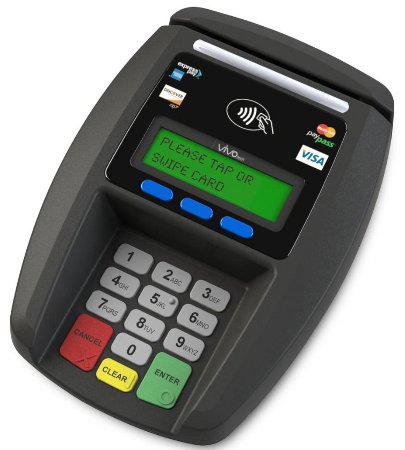Payment terminal accepts NFC mobile-phone payments
Apr 14, 2010 — by Eric Brown — from the LinuxDevices Archive — 23 viewsVivotech announced a Linux-based mobile payments device that incorporates Near Field Communication (NFC) wireless technology. The ARM9-based, PCI 2.1-certified “Vivopay 8100” offers a traditional pinpad and mag-stripe reader, but also supports contactless payments via NFC-enabled mobile phones, with features such as coupon redemption and discount vouchers.
Announced at the Electronic Transactions Association (ETA) show in Las Vegas this week, the customer-facing Vivopay 8100 is the latest in Vivotech's line of Vivopay payment devices. The device enables small and medium-size merchants to accept mag-stripe, as well as contactless payments using ISO 14443, MiFare, and NFC mobile payment standards, says Vivotech.
Certified for the PCI PED (Payment Card Industry PIN-Entry Device) 2.1 standard, the device offers secure PIN entry of debit card transactions. Signature capture is also available, for other types of payment card, the company adds.

Vivopay 8100
(Click to enlarge)
A dual-line, backlit LCD screen can display up to 32 characters, and the 13-key pinpad is recessed for greater privacy, says Vivotech. The tactile pinpad is said to comply with ADA standards, enabling easier use by the visually impaired, says the company. The device is also said to include a three-track, bi-directional mag-stripe reader, and an optional SAM (secure access module).
The Vivopay 8100 measures 7.5 x 5.1 x 1.9 inches (190.5 x 129.35 x 47.63mm), and weighs 0.9 pounds (0.4 k), says Vivotech. The device may be powered by either the 9 to 12 VDC supply or via the USB port, at 5 Volts, says the company. Operating temperature can range from 14 to 158 deg. F (-10 to 70 deg. C).
In addition to supporting PCI PED 2.1, the Vivopay 8100 is certified by all major credit card companies, and offers Master Session, DUKPT, and 3DES security, says Vivotech. The device is said to interface with the most popular POS and ECR systems, and offers remote firmware updates.
The Vivopay 8100 is designed to connect with Vivotech's server-based mLoyalty software, which allows merchants to deliver personalized coupons and offers to their customers' cellphones, says the company. The software is said to enable the delivery of personalized mobile loyalty and marketing programs.
About NFC
Near Field Communication (NFC) is an extension of the ISO 14443 standard for RFID-based proximity cards, which also includes Sony's more well-established FeliCa contactless RFID technology, which is used in Japan, Hong Kong, and Singapore. NFC is designed to offer a more power-efficient and affordable alternative to Bluetooth for very short-range, low-bandwidth applications, while also providing a more robust, bandwidth-rich alternative to RFID and other "contactless" technologies.
NFC uses magnetic loop induction technology to transmit data over four centimeter distances at up to 424Kbps using the unlicensed 13.56MHz band. The technology supports both passive (one-way) and active (two-way) modes, the latter being similar to Bluetooth transfers.
About Vivotech
Vivotech claims to have shipped over 660,000 contactless and NFC payment terminals to more than 35 countries. In 2009, Vivotech received the Frost and Sullivan North American Smart Cards Product Line Strategy of the Year Award, and this year it won the 2010 Mobility Award for its NFC mobile Vivowallet software, says the company. Vivotech investors are said to include Citi, First Data Corporation, Motorola Ventures, NCR, and Nokia Growth Partners.
Availability
Vivotech did not offer pricing or availability information on the Vivopay 8100, but will demonstrate the product today and tomorrow at booth #424 at the ETA show in Las Vegas. More information on the Vivopay 8100 should eventually appear on the company's Vivopay page, here.
This article was originally published on LinuxDevices.com and has been donated to the open source community by QuinStreet Inc. Please visit LinuxToday.com for up-to-date news and articles about Linux and open source.